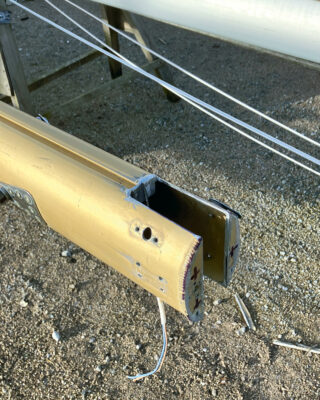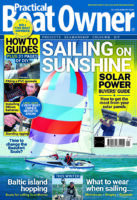Winston Collinge and his boating pal John Beck repair the mast forestay on their 40-year-old Colvic Atlanta sailboat after severe weather knocks it down.
In January of 2023, we lost our sailboat forestay, writes John Beck.
Strong winds had been forecast, but it was nothing we had not seen before. Our sailing yacht Resolute, a Colvic Atlanta, was cosily tied up in a freshwater berth in a canal basin at Glasson Marina, Lancaster.
But at 0200 her owner Winston had a phone call from the very diligent – and sleepless – next door boat owner saying the sailboat’s forestay and foresail had been carried away and were dragging in the water.

Forestay hangs over the side after its mast attachment broke. Photo: Winston Collinge.
That is the sort of thing that certainly gets a sailor out of bed. By 0600 it was clear the attachment to the top of the mast had broken away near the point where it was welded to the truck.
Damage to the sailboat forestay

The aluminium was torn like paper on the broken forward part of the mast. Photo: Winston Collinge.
The aluminium had been torn like paper, maybe made more brittle by the heat of the weld. There was also a suspicious-looking repair, with stainless steel wrapped around the aluminium and rather crudely fixed.
By some miracle the mast was still upright, held up by a wing and a prayer, but the boom had been dislodged from the gooseneck and was hanging by the main halyard.
The foresail halyard, an 8mm rope, was snapped like a piece of string. Another miracle was the foresail being still perfectly furled and held on to the forward part of the boat by the bow fixing although most of the foresail was in the water. So we had something to work with.

The backstay and topping lift block are still intact; note the wraparound stainless steel fitting. Photo: Winston Collinge.
Quick problem solving after a broken forestay
The worst of the storm was over but the wind was still too strong to unfurl any sails. The first job was to secure the mast so it would not come crashing down onto the wheelhouse, so we removed the boom to lighten the load.

Welded sections were cut away to allow the top box to fit, held by bolts tapped through the thicker top with a backing strip added. Photo: Winston Collinge.
We fixed the topping lift to the anchor roller and what was left of the foresail halyard to the windlass, and winched up as best we could to pull the mast forward and hold it in place. It was going to be a couple of days until we could get to the boat lift to remove the mast, since that is how it is done in Glasson.

The top box could now be bolted in place and the stays replaced, and the whole assembly was finally fitted to the boat. Photo: Winston Collinge.
The forestay was twisted in its fixing at the top, the foil sections which hold the foresail were bent, and the plastic joiners had snapped at the point where they connected together. On the mast itself, one of the pop rivets holding the spreaders had parted company, and the spreader was slightly bent.

Repair underway. Photo: Winston Collinge.
The brand new, never used, foresail was removed and sent back to the sail makers and condemned as being stretched and creased out of shape, but fortunately, the Plastimo furling mechanism was completely undamaged.

Photo: Winston Collinge.
The mast was removed, and the search began for a repair. But a burning question remained:
The boat is insured, but would the insurers pay out on what had clearly been a bodged previous repair?
DIY decision
Totting up the possible cost, do we really have to have a new mast?
We certainly needed a new foresail and new forestay. The entire foil sections come from France, and since the Brexit lunacy, getting stuff through customs was a nightmare. Added to that, a busy summer sailing Resolute around Britain via the Caledonian Canal had been planned, and that adventure was now in jeopardy.

Masthead unit bolted on. Photo: Winston Collinge.
On this mast, the whole of the top section is welded into place, and the halyards do not pass down the centre of the mast, which can cause sleepless nights in a windy marina!
It was clear that all the aluminium welds must now be suspect, and trying to weld in something new would not be a preferred option.
Finding a solution
By chance, I came across a mast ‘top box’ (a new concept to me) made by Seldén, on sale on eBay for a modest price. I jumped at the chance and bought it with my fingers crossed. It was a lucky purchase, just the right size and had points for us to attach all the equipment at the top of the mast.
To fit it in place, we cut away all the welded sections which hold the sheaves in place so that the new head box just fitted perfectly. They are normally held in place with J-bolts hooked into the wall of the mast, but in our case, we were not sure if the mast wall was thick enough to stand the strain. We opted to leave part of the top of the mast, which was much thicker, in place, and bolt through that with a backing plate, then hold the top box in place with 8mm stainless steel bolts and Nyloc nuts.

All fixed! Winston’s 40-year-old Colvic Atlanta Resolute at Whitby Marina. Photo: Winston Collinge.
Conclusion: What does it take to fix a sailboat forestay?
The likely cost of replacing the whole mast would have been excessive for the overall value of the boat.
We made a claim on my insurer, GJW Direct Boat Insurance, for a new foresail and roller furling gear etc. An assessor was sent out, but he was happy for us to do the work. I was in possession of a very recent survey commissioned by the previous owner, who hadn’t picked up on the rigging repair defect. The insurer’s surveyor inspected the damage, then returned after we had completed repairs to verify all had been done properly. GJW Direct paid up and didn’t take an excess.
Does it work? Well, this incident delayed our circumnavigation plans, but Resolute and her new masthead made it around Britain without any problems.

Photo: Winston Collinge.
Total repair cost
The repair costs (and insurance claim) totalled £2,222.
This included:
- £420 for new aluminium foils from Jimmy Green
- £89 for a Seldén Headbox from eBay
- £208 for the Aquavista Marine Mast lift and installation
- £140 repairs to forestay
- £1,365 foresail from Impact Marine
The expert view on fixing a sailboat forestay
Keith Lovett, senior underwriter for Stoneways Marine, comments:
Having considered Mr Collinge’s plight, he appears to have a supportive insurer, content to have assisted him when potentially it may have avoided a claim. Resolute’s foresail remained furled; hence, we might assume that the owner was using his yacht throughout the winter.
If not, and perhaps laid up afloat during the worst of the winter, as many marinas increasingly demand, removing the foresail is good practice, reducing windage and providing an opportunity to clean, service, and safely store. The accident appears to have identified a previous ‘suspicious-looking repair’.
Resolute was 40 years old, we understand that Mr Collinge may have relied on a previous owner’s survey when buying and insuring his yacht. While that may have provided sufficient comfort to proceed, it should be remembered that a surveyor would have no contractual liability to a new owner.
If you need to rely on a survey, you should instruct your own surveyor.
On top of that, periodic rig inspection and maintenance will be essential to meet the requirements in all policies that any vessel should be maintained in such a way to operate safely. Reputable riggers suggest visual inspection several times a year, fitting inspection and lubrication at least once a year and a full rig service and refurbishment as may be necessary every four years.
Insurers generally do not provide cover for an inherent defect, which could have been reasonably detected prior to any loss. Replacing the defective part, in this case the mast, would not be covered by many policies. Similarly, damage caused by gradual deterioration would be excluded unless the vessel has been adequately maintained, hence the need for the rigging inspection.
Seeing as Resolute was marina-based, its policy is likely to include what are termed marina benefits.
If a claim occurs while the vessel is moored in its normal marina, insurers will not apply the policy excess. This appears to be the case here.
In order to avoid any surprises later on, any owner should at least familiarise themselves with their insurance policy, the core benefits and exclusions.

Winston Collinge (left) and boating pal John Beck met in 2018 as volunteers at a historic mill in Lancaster. Both having engineering backgrounds, they’ve made many improvements to the 32ft Colvic Atlanta Resolute. Their mast repair later survived very rough weather around Land’s End.
Do-it-yourself mast stepping
If you’re thinking of hiring a boatyard crane to step your mast, why not consider this low-tech, low-cost alternative? Rupert…
Snap, shackle and drop: coping with a dismasted sailing yacht
Steve Hodges and his fiancée Sam McClements’ second attempt at the RYA Yachtmaster Ocean passage is scuppered by a dismasted…
Coping with a dismasting & rig checks
Faced with a sudden dismasting in 40-knot gusts, Rupert Holmes explains how he and his crew saved his boat, and…
How a thorough rig inspection saved my mast and our Atlantic crossing
As a former RAAF (Royal Australian Air Force) aircraft technician, I was always going to perform a thorough rig check…
Want to read more articles like Fixing a sailboat forestay after storm damage?

A subscription to Practical Boat Owner magazine costs around 40% less than the cover price.
Print and digital editions are available through Magazines Direct – where you can also find the latest deals.
PBO is packed with information to help you get the most from boat ownership – whether sail or power.
-
-
-
- Take your DIY skills to the next level with trusted advice on boat maintenance and repairs
- Impartial, in-depth gear reviews
- Practical cruising tips for making the most of your time afloat
-
-
Follow us on Facebook, Instagram, TikTok and Twitter








